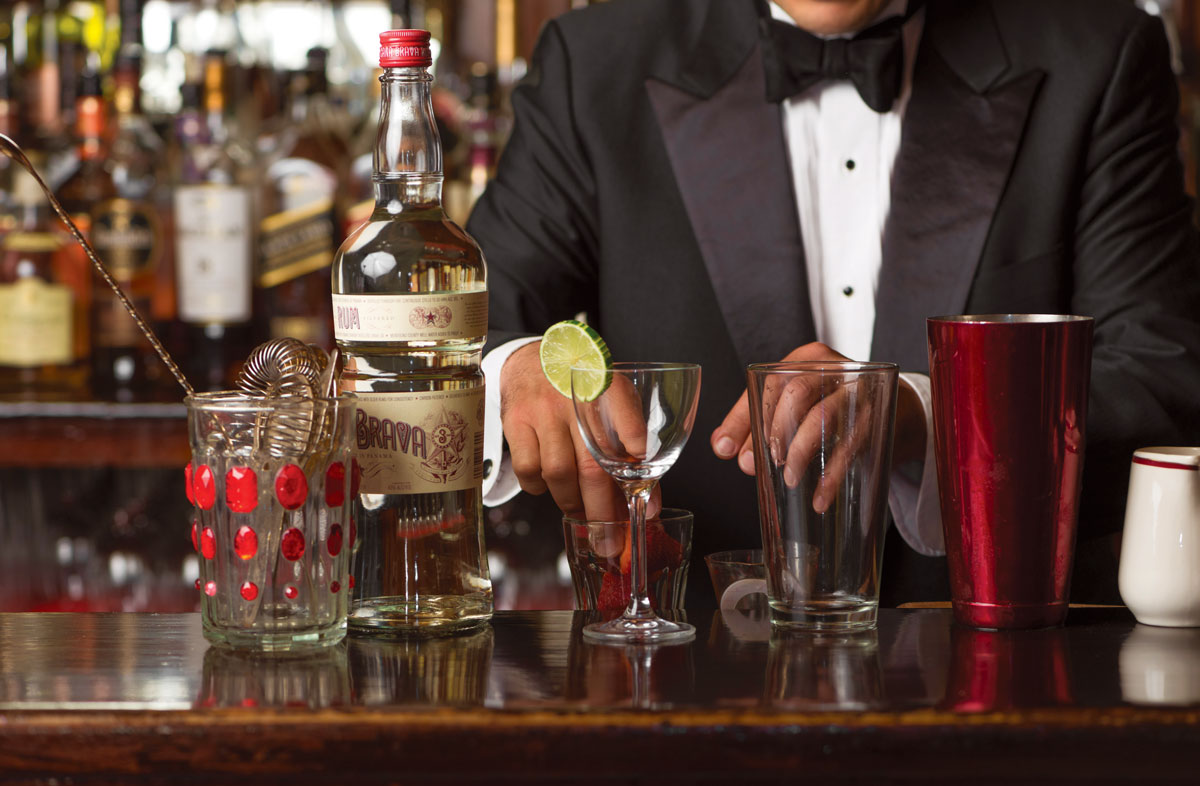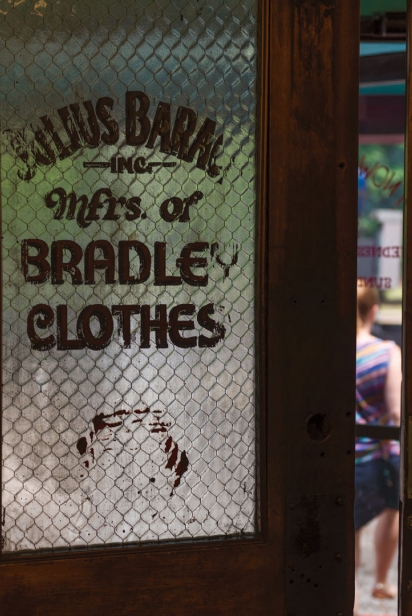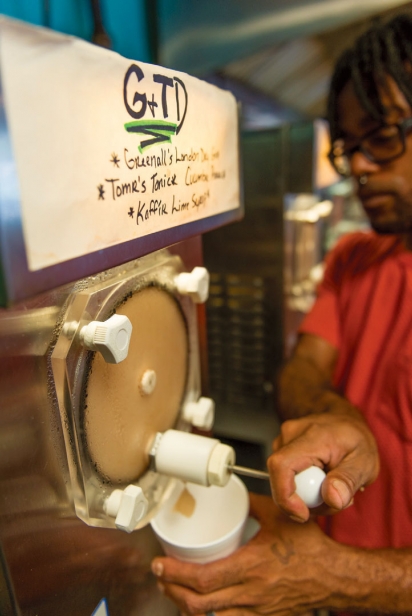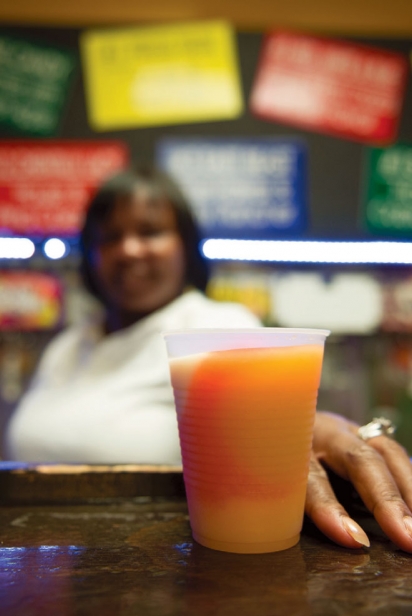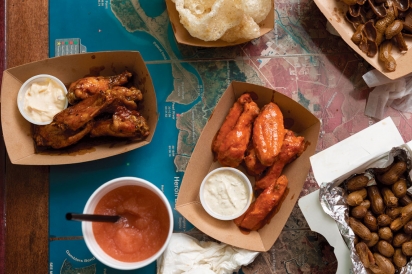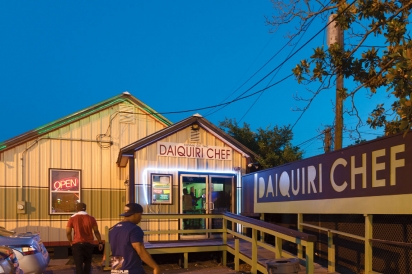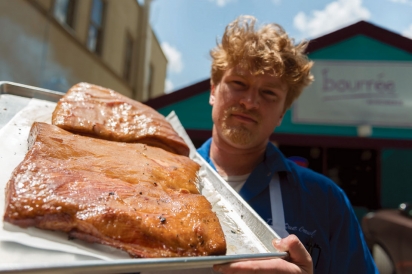Elevating the Daiquiri
Upgraded ingredients and techniques improve a local staple
Timed just right, one could leave the hymns and foot stomps in the sanctuary and second-line in the streets with a daiquiri. Many times as church is letting out, a social aid and pleasure club is parading through New Orleans neighborhoods. And on one of those streets, you’ll likely find the daiquiri man, following the brass band and pulling his generator-powered frozen drink dispenser along in a wagon. Daiquiris are everywhere in New Orleans.
“Probably one of the first signs you see in the airport is for daiquiri and strip clubs,” quipped Braden LaGrone, a bartender at Cure. The French Quarter is inundated by daiquiri shops, drive-ins and tourists with Technicolor tongues toting the ubiquitous Styrofoam cups.
Daiquiris “had become such bullshit,” he said. “You see what they are on Bourbon Street.” But about four years ago, LaGrone said as he poured from a bottle of Denizen, a white rum aged in oak for three years, daiquiris here in New Orleans started getting better.
There are more than 20 shops in the city primarily selling frozen daiquiris. Outside Louisiana, the drink has become like most gumbos: a derivative far from the original. The legend goes that in the early 1900s, Jennings Cox, an American mining engineer living in Cuba, claimed credit for inventing the daiquiri: rum, lime, sugar, ice—and shaken up. The 1938 invention of the blender coupled with the dearth of whiskey in the ’40s and ’50s meant that rum, vodka and icy drinks became popular. With that, the whispers of frozen daiquiris became screams.
Chug and chug, it sounded like a steam locomotive gaining speed, as LaGrone used both hands to shake and chill the drink in a silver shaker. Edison light-bulbs hovered above his head at Cure, the bar on Freret Street that was a firehouse in the 1800s. Now, it’s fitted with leather sectionals and plenty of exposed bricks. There was an early happy hour crowd and The Beatles’ “She Said,” The Kinks’ “Days” and The Byrds’ “Why” played through the speakers.
“It’s real simple, man,” he said about the original daiquiri. “And when the balance is right on, it is refreshingly light and really good in our climate.” For him, balance is dry, citrus forward; not too sweet, tart and has texture. The simple drinks are the hardest to make; one can mask deficiencies with a lot of ingredients.
The daiquiri is LaGrone's measuring stick when he’s checking out a bar’s program. He wants to know if the bartender picked the right rum and shook it well. A good daiquiri gives him a solid indication of the quality of the rest of the drinks menu.
LaGrone reached for a red peeler in a basket of lemons, limes and oranges that sat on the bar. His tattoo, Ben Franklin’s “Join, or Die” political cartoon of a snake divided into eight parts, showed on his right forearm as he poured the daiquiri into a coupe.
LaGrone mentioned drinking surrounding the Declaration of Independence. But it was the transporting of another group of people, who wouldn’t be free for another 87 years, that contributed to the spread of rum and a related drinking culture among New Orleans and the Caribbean. LaGrone said: “It has everything to do with the slave and spice trade.” New Orleans is located in the Gulf of Mexico and its role as a major port city, was, and still is, a gateway to the Caribbean and the rest of the United States. The main products were sugar, tafia (a low-grade rum) and bananas. The tropical climate here is generally similar to that in Cuba, where the daiquiri was perfected at La Floridita. While the frozen variety has mostly pushed out the “Daiquiri Naturale” in Cuba today, the fact remains that some of the best rum flows from Cuba.
In New Orleans when the weather is summery—about nine months of the year—it seems as if almost everybody from New Orleans East is at a daiquiri shop on Sundays. On a small strip of road along the Chef Menteur exit of I-10, as the sun set on a recent Sunday, folk and cars started to congregate at Daiquiri Chef. Smoke bellowed from a large grill in a trailer bed; the barbecue was for sale. Meticulously detailed automobiles—with rims, lights and loud music—cruised the street in search of the parking spots that would give their cars the most visibility. It was a peerjudged car show. Men popped wheelies on ATVs with women on the back, holding tightly to the men’s waists, hair dangling above the street. Inside Daiquiri Chef, a small trailer-like building, Kevin Gates’s “Would You Mind” played loudly.
“What up, Fam,” Jeremy Davis asked a female patron.
“Gimmie my medium, not too strong, and the large, I don’t give an eff about,” she said.
“I gotcha,” he replied.
Gallons are $24 and $21 on Sunday. There are more than 20 flavors; the number 11 was a “Danziger, All Daiquiri & No Milk, with a Shot 190.” This daiquiri’s namesake is the bridge, located less than a mile away, that became infamous after members of the New Orleans Police Department shot and killed unarmed people days after Hurricane Katrina. Yo Gotti’s “Law” played from jukebox next to a Romare Bearden poster of a jazz septet.
“I’ve been selling daiquiris about half of my life, since I was 20,” Davis said. He’s 35 now and said the beverage is popular because it’s not a beer, it’s not too hard and it’s more of an outdoor drink. Like many New Orleanians, Davis grew up sipping daiquiris at parties and while eating crawfish on Lake Pontchartrain. “It’s refreshing and just makes sense when you’re walking around cooling.”
James Denio, a partner at Bourrée at Boucherie, didn’t grow up drinking the frozen treat—he’s from New Jersey. He and his business partner, Chef Nathanial Zimet, were both independently inspired to make fresh cocktails in the form of a daiquiri when they had fresh fruit varieties at various depots in Louisiana. At their eatery on a recent Saturday, three flavors were available. The first, called the G + TD, a riff on a gin and tonic, was made with cucumber as well as kaffir lime leaves that had been crushed, boiled and made into a tea creating, created a sharp citrus flavor with cinchona bark quinine.
Denio said they are interested in making delicious drinks into handcrafted frozen drinks and fresh anything is going to better. They are inspired by craft cocktails in their frozen endeavors, making a passion fruit purée to get the color for their Rubin “Hurricane” Carter (named for the Canadian boxer wrongfully convicted of murder and later released after spending nearly 20 years in prison). Daiquiris are inherently “campy,” Denio said.
“There’s seriousness about cocktails, there’s seriousness about cuisine and there’s seriousness about wine,” he said. “And we take daiquiris serious, but one of the things about daiquiris is that you don’t have to be so serious.”
In the 1800s, ice in New Orleans was no laughing matter. The city was a major exporter of ice and ice houses were ubiquitous. Wayne Curtis, a contributing editor to The Atlantic and the author of And a Bottle of Rum: A History of the New World in 10 Cocktails, recalled a report from around 1840, when the ice houses were running out and weren’t receiving any shipments and the city was going to be without ice and “people just freaked the fuck out.” Curtis added that “between the heat and the appreciation for a good ice drink, the stage was set for the frozen daiquiri to take off.”
He attributes the drink’s resurgence to people returning to simpler approaches to things and said rum is about as simple as one can get. He added that lime and rum and sugar have been together for at least 300 years, from the time the British Navy started issuing wines. But it took it until the early 1900s to get it worked out.
“People are exploring every single aspect of earlier drinks, trying to reinvent and play around with them,” Curtis said. He elaborated, it’s natural for people to explore these frozen machine drinks and try to improve on them. He noted that mixology requires a lot of skill and bartenders tend to move around frequently and quality control of the drinks becomes an issue.
“But you can get rid of that if you can just batch up some drinks and hire someone to pull a lever,” he said, “where it’s more like a beer bar and all you have to do is hire some dude who knows a few things about IPAs and can work a tap.” So there is a rise in batch cocktails, and the daiquiri is an extension of that.
He likes the innovations of daiquiris at bar programs like St. Lawrence and said he will go out of his way to get one from Gene’s Po-Boys and Daiquiris.
“One of the things that I love about New Orleans is that you can go places and everyone is talking about daiquiris,” Curtis concluded.


